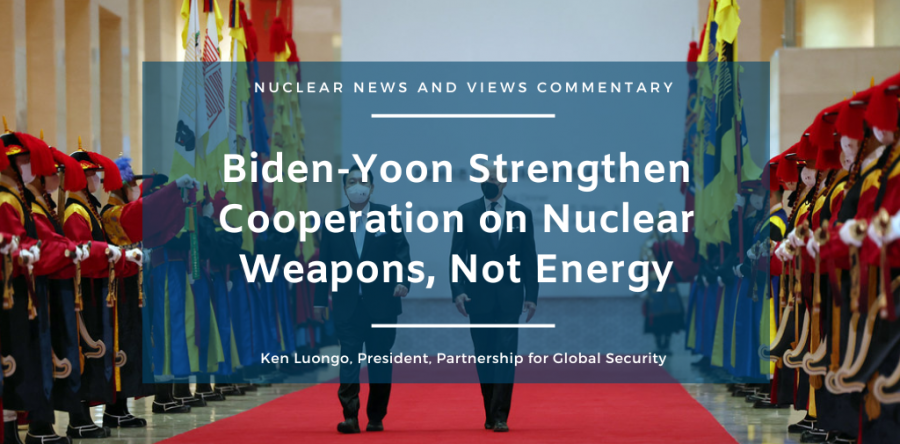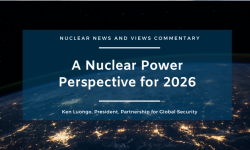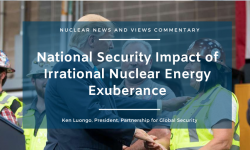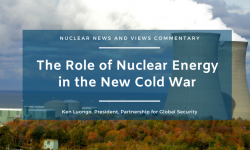In the forest of U.S.-South Korea relations it seems that there is still only one Redwood, North Korea. Amid the expanding grove of Biden-Yoon summit commitments last week, the towering deliverable was the Washington Declaration, designed to strengthen U.S. deterrence commitments to South Korea and further involve Seoul in American nuclear weapons planning.
This initiative was intended to defuse the Korean desire for its own nuclear devices in the face of the ever expanding North Korean nuclear and missile threat. However, the result did not resonate with some Korean conservatives.
Preventing war on the Korean peninsula is the paramount objective. But stunted and withering in the shadow of the Washington Declaration was bilateral civil nuclear energy cooperation. This is an area where the collaborative nuclear agenda can make positive contributions to global advancement rather than facilitate its destruction.
Unlike the two preceding U.S.-ROK summit statements in 2021 and 2022, the documents did not commit the two countries “to develop cooperation in overseas nuclear markets, including joint participation in nuclear power plant projects” or “commit to greater nuclear energy collaboration and accelerating the development and global deployment of advanced reactors and small modular reactors.”
Instead, it nebulously noted that each nation will promote “the responsible development and deployment of civil nuclear energy globally,” commit to the IAEA safeguards Additional Protocol “in global civil nuclear cooperation,” and respect the “other’s export control regulations and intellectual property rights.” A press release from a side meeting between the U.S. Secretary of Energy and the Korean Minister of Trade, Industry and Energy echoed the empty presidential statement on nuclear cooperation.
This rhetorical recission is the poison fruit from the multi-year fight between the two nation’s largest nuclear companies, KEPCO and Westinghouse. It is a significant sign of continuing and potentially accelerating trouble in the bilateral nuclear power relationship at a time when greater solidarity is required.
Ordinarily, the forcing mechanism of the summit would create the conditions for a resolution of the commercial conflict. But it seems the dispute was either unsolvable or too low a priority on the summit agenda.
The companies have missed two deadlines for agreement, one in mid-March and now the summit. The lack of progress on the issue probably means that Westinghouse’s lawsuit against KEPCO and its subsidiary, KHNP, will proceed.
It is likely that the legal issue in dispute – whether Korea’s APR-1400 nuclear reactor contains Westinghouse controlled technology and therefore is subject to U.S. export controls – will be resolved in favor of the American company. Korean officials know this.
So, it’s hard to understand what the endgame for either side is in perpetuating this bitter battle. In the wake of Russia’s invasion of Ukraine, the large reactor market is only growing. And that seems to be the problem. The two nuclear goliaths are fighting for market share. But it is questionable whether either company has the capacity alone to complete all the reactors they are seeking.
The fact remains that each is integrally dependent on the other for building their reactors and both make money from the other’s success. Increasing the rivalry beyond its already elevated level could create deep alienation, significantly reshape supply chains, help authoritarian nation nuclear suppliers, and undermine global climate and energy imperatives.
The two central battlegrounds are Eastern Europe and the Middle East. Eastern European nations considering future reactors are leaning toward America.
There is an agreement for multiple Westinghouse reactors to be built in Poland. There is a separate private deal between a Polish power company and KEPCO for two reactors, but its implementation could be a challenge. Romania is interested in the American small modular reactor from NuScale. Bulgaria has signed an MOU with Westinghouse for one to two new reactors. And the Czech Republic is evaluating Korean, American, and French reactor offers.
KEPCO has submitted a proposal to Turkey for four new nuclear plants where it will face off against Russia, which is already constructing nuclear reactors in the country. There also is opportunity in the U.K, which has made a major commitment to nuclear energy expansion. Recently, South Korea and the U.K. signed a joint agreement on nuclear cooperation that could open the door to involvement in Britain’s new nuclear construction. Then there are other nations, like India, that are interested in additional large reactors to serve its growing energy needs.
In the Middle East, the major nuclear export target at the moment is Saudi Arabia. But it is difficult to discern the Saudi leadership’s preferred pathway.
It has stated a desire for U.S. assistance with its nuclear development but has excluded Westinghouse from its list of potential vendors. The kingdom has expanded its nuclear relationship with China, which is looking for an overseas market beachhead for its Hualong reactor. But there is no commitment to purchase the plant. It has invited Russia’s state nuclear company, Rosatom, to bid on its reactors despite Russia’s battered reputation from the invasion of Ukraine.
The Saudi leadership can clearly see the success that South Korea has had in building four of its reactors in the United Arab Emirates. And KEPCO is now supporting Russia in constructing Egypt’s initial nuclear plant, making it, along with Rosatom, a leading Middle East nuclear supplier.
If the U.S. cannot directly cooperate with Saudi Arabia, the next best choice from the American government’s perspective should be South Korea, not China or Russia.
Because of the dependence of the Korean reactor on U.S. export approvals, that could be very challenging to pull off. It is virtually inconceivable that the U.S. Congress would agree to a U.S.-Saudi nuclear cooperation agreement in the foreseeable future. The legislative body has the final word on the approval of official nuclear cooperation deals and its animosity toward Saudi Arabia is high.
But U.S. support for a Korean bid may not be impossible, particularly if the Saudi government softened its opposition to the safeguards Additional Protocol. Or if Saudi leadership raised the stakes by indicating a preference for Chinese or Russian reactors or considered Egypt as a model for Korean-Russian joint construction.
If Korea decided to move forward with a Saudi deal without U.S. approval and support, perhaps using UAE and Saudi financing and new suppliers, it would decimate the bilateral nuclear relationship of trust these nations have developed over decades. That is not an outcome anyone should desire, and it is dangerous. It is the reason why the corporate conflict needs to be settled amicably, fairly, and quickly.
Beyond large reactors, the small reactor market is emerging. Here, there is some good news from the summit. The two leaders committed to “build capacity in recipient countries”, referring to those nations that may want nuclear energy but are not well prepared for it.
The IAEA has a number of programs that help support nations in their development of nuclear energy-related capacities. But more is needed in relation to small reactors, some of which may not fit well within current IAEA guidance.
Evolving that guidance and intensively building capacity in these nuclear newcomer nations is an area on which the U.S. and South Korea should cooperate. The objective should be to have at least three developing economy nations interested in small reactors prepared for their deployment in the next decade.
The Biden-Yoon summit did not deliver progress on bilateral nuclear cooperation the way it did on nuclear weapons planning. The Washington Declaration is an indication that the Obama-era vision for a “world without nuclear weapons” is giving way to the cold-eyed realities that threatened nations will consider the creation of their own atomic arsenals and that the deterrent value of nuclear weapons remains salient.
But another reality is that the cooperative nuclear energy agenda is essential for other critical global goals including zero-carbon power, energy security, technology superiority, and geostrategic advantage over Russia and China. A retreat by the U.S. and South Korea from their once-heralded nuclear power collaboration will undermine all of these objectives. But, apparently, it’s hard for Washington and Seoul to see the forest for the trees.
Ken Luongo, President, Partnership for Global Security






